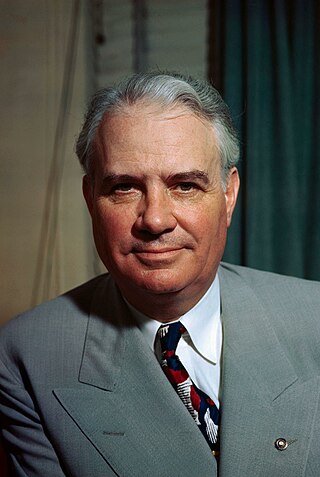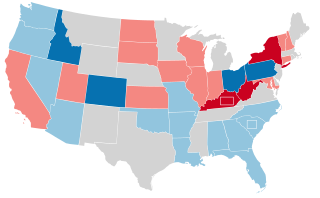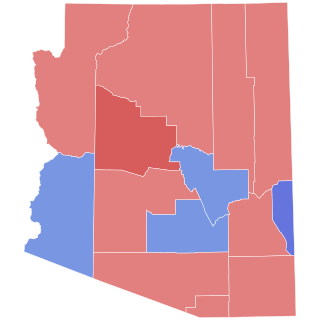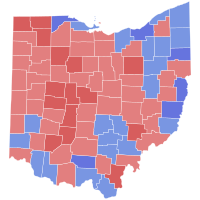
John William Bricker was an American politician and attorney who served as a United States senator and the 54th governor of Ohio. He was also the Republican nominee for Vice President in 1944.

Stephen Marvin Young was an American politician from the U.S. state of Ohio. A member of the Democratic Party, he served as a United States senator from Ohio from 1959 until 1971.

The 1976 United States Senate elections was an election for the United States Senate. Held on November 2, the 33 seats of Class 1 were contested in regular elections. They coincided with Democrat Jimmy Carter's presidential election and the United States Bicentennial celebration. Although almost half of the seats decided in this election changed parties, Carter's narrow victory did not provide coattails for the Democratic Party. Each party flipped seven Senate seats, although, one of the seats flipped by Democrats was previously held by a Conservative.

The 1970 United States Senate elections was an election for the United States Senate. It took place on November 3, with the 33 seats of Class 1 contested in regular elections. Special elections were also held to fill vacancies. These races occurred in the middle of Richard Nixon's first term as president. The Democrats lost a net of three seats, while the Republicans and the Conservative Party of New York picked up one net seat each, and former Democrat Harry F. Byrd Jr. was re-elected as an independent.

The 1968 United States Senate elections were elections for the United States Senate. Held on November 5, the 34 seats of Class 3 were contested in regular elections. They coincided with the presidential election of the same year. The Republicans picked up five net seats in the Senate. This saw Republicans win a Senate seat in Florida for the first time since Reconstruction.

The 1964 United States Senate elections were held on November 3. The 33 seats of Class 1 were contested in regular elections. Special elections were also held to fill vacancies. They coincided with the election of President Lyndon B. Johnson by an overwhelming majority, to a full term. His Democratic Party picked up a net two seats from the Republicans. As of 2023, this was the last time either party has had a two-thirds majority in the Senate, which allowed the Senate Democrats to override a veto, propose constitutional amendments, or convict and expel certain officials without any votes from Senate Republicans. However, internal divisions would have prevented the Democrats from having done so. The Senate election cycle coincided with Democratic gains in the House in the same year.

The 1962 United States Senate elections was an election for the United States Senate. Held on November 6, the 34 seats of Class 3 were contested in regular elections. Special elections were also held to fill vacancies. They occurred in the middle of President John F. Kennedy's term. His Democratic Party made a net gain of four seats from the Republicans, increasing their control of the Senate to 68–32. However, this was reduced to 67–33 between the election and the next Congress, as on November 18, 1962, Democrat Dennis Chávez, who was not up for election that year, died. He was replaced on November 30, 1962, by Republican appointee Edwin L. Mechem. Additionally, Democrat Strom Thurmond became a Republican in 1964, further reducing Democrats to 66–34. This was the first time since 1932 that Democrats gained seats in this class of Senators.

The 1958 United States Senate elections were elections for the United States Senate which occurred in the middle of President Dwight D. Eisenhower's second term. Thirty-two seats of Class 1 were contested in regular elections, the new state of Alaska held its first Senate elections for its Class 2 and 3 seats, and two special elections were held to fill vacancies.

The 1956 United States Senate elections were elections for the United States Senate that coincided with the re-election of President Dwight D. Eisenhower. The 32 seats of Class 3 were contested in regular elections, and three special elections were held to fill vacancies. Although Democrats gained two seats in regular elections, the Republicans gained two seats in special elections, leaving the party balance of the chamber unchanged.

The 2000 United States Senate election in Ohio took place on November 7, 2000. Incumbent Senator Mike DeWine won re-election to a second term. His victory made him the first Republican re-elected to the Senate in Ohio since John W. Bricker in 1952. As of 2024, this is the last time that the Republicans won Ohio’s Class 1 Senate seat.

The 1958 United States Senate election in Arizona took place on November 4, 1958. Incumbent Republican U.S. Senator Barry Goldwater ran for reelection to a second term, and defeated former U.S. Senator, and then-Governor, Ernest McFarland in the general election. The election was a rematch from 1952, where Goldwater defeated McFarland by a narrow margin. Goldwater had attributed the 1952 win to the unpopularity of President Harry S. Truman and popular Wisconsin Senator Joseph McCarthy endorsing his campaign.

The 1958 United States Senate election in Montana took place on November 4, 1958. Incumbent United States Senator Mike Mansfield, who was first elected to the Senate in 1952, ran for re-election. Mansfield won the Democratic primary comfortably, and moved on to the general election, where he was opposed by Lou W. Welch, a millworker and the Republican nominee. In contrast to the close campaign in 1952, Mansfield defeated Welch in a landslide and won his second term in the Senate easily.

The 1952 United States Senate election in Ohio was held on November 4, 1952.

The 1946 United States Senate elections in Ohio was held on November 5, 1946, alongside a concurrent special election to the same seat.

The 1970 United States Senate election in Ohio took place on November 3, 1970. Incumbent Democratic Senator Stephen M. Young did not run for re-election to a third term in office. U.S. Representative Robert Taft Jr. won the open seat over Democrat Howard Metzenbaum.

The 1964 United States Senate election in Texas was held on November 3, 1964. Incumbent Democratic US Senator Ralph Yarborough defeated future US President George H. W. Bush handily. This would prove to be Yarborough's final term as a senator. Bush later went on to win an election for the US House of Representatives in 1966 and was subsequently elected US Vice President in 1980, re-elected in 1984, and was elected president in 1988.

The 1958 United States Senate election in Rhode Island took place on November 4, 1958. Incumbent Democratic U.S. Senator John Pastore successfully sought re-election, defeating Republican Bayard Ewing in a repeat of their 1952 race.

The 1962 United States Senate election in Washington was held on November 6, 1962. Incumbent Democratic U.S. Senator Warren Magnuson won a fourth term in office, narrowly defeating Republican nominee Richard G. Christensen.

The 1964 United States Senate election in Ohio took place on November 3, 1964. Incumbent Democratic Senator Stephen M. Young was re-elected to a second term in office, narrowly defeating Republican U.S. Representative Robert Taft, Jr.

The 2022 New Hampshire Senate elections took place as part of the biennial 2022 United States elections. New Hampshire voters elected state senators in all of the state's 24 senate districts. State senators serve two-year terms in the New Hampshire Senate, with all of the seats up for election each cycle. The primary elections held on September 13, 2022, determined which candidates would appear on the November 8, 2022, general election ballot.






















